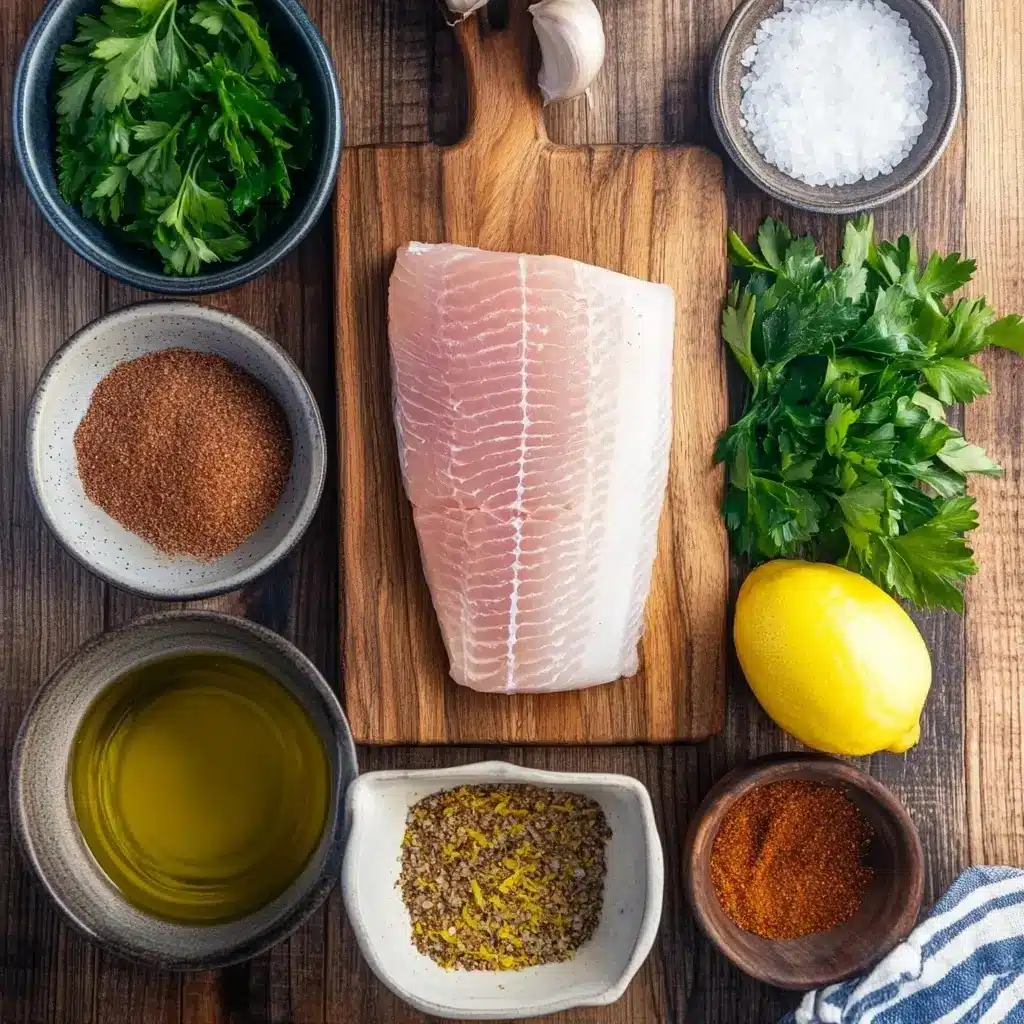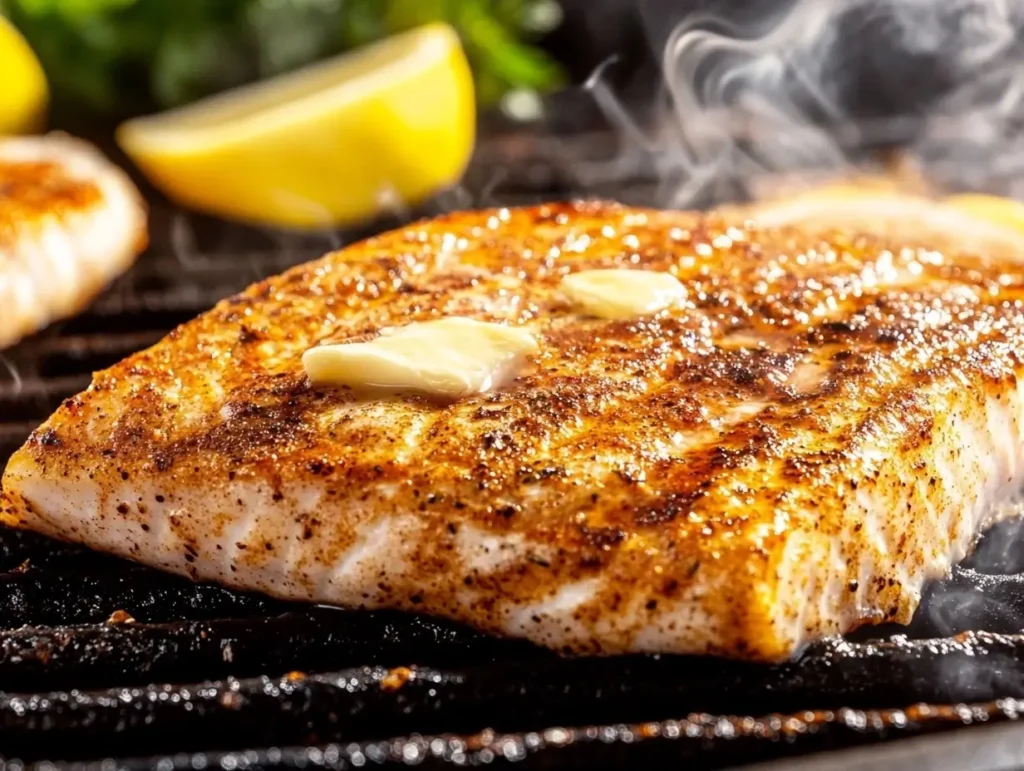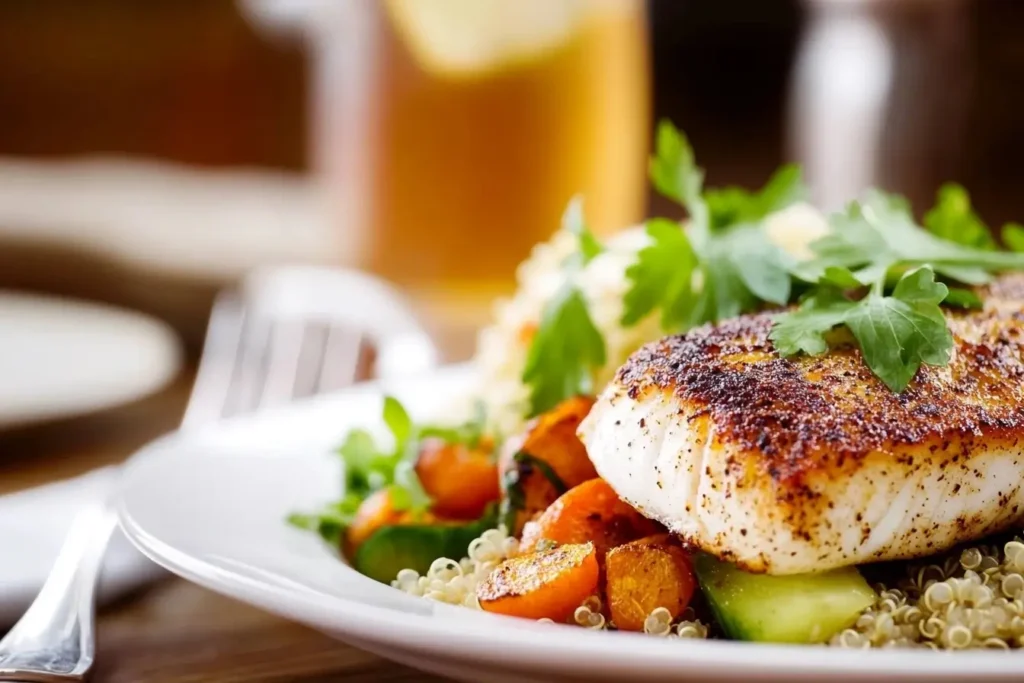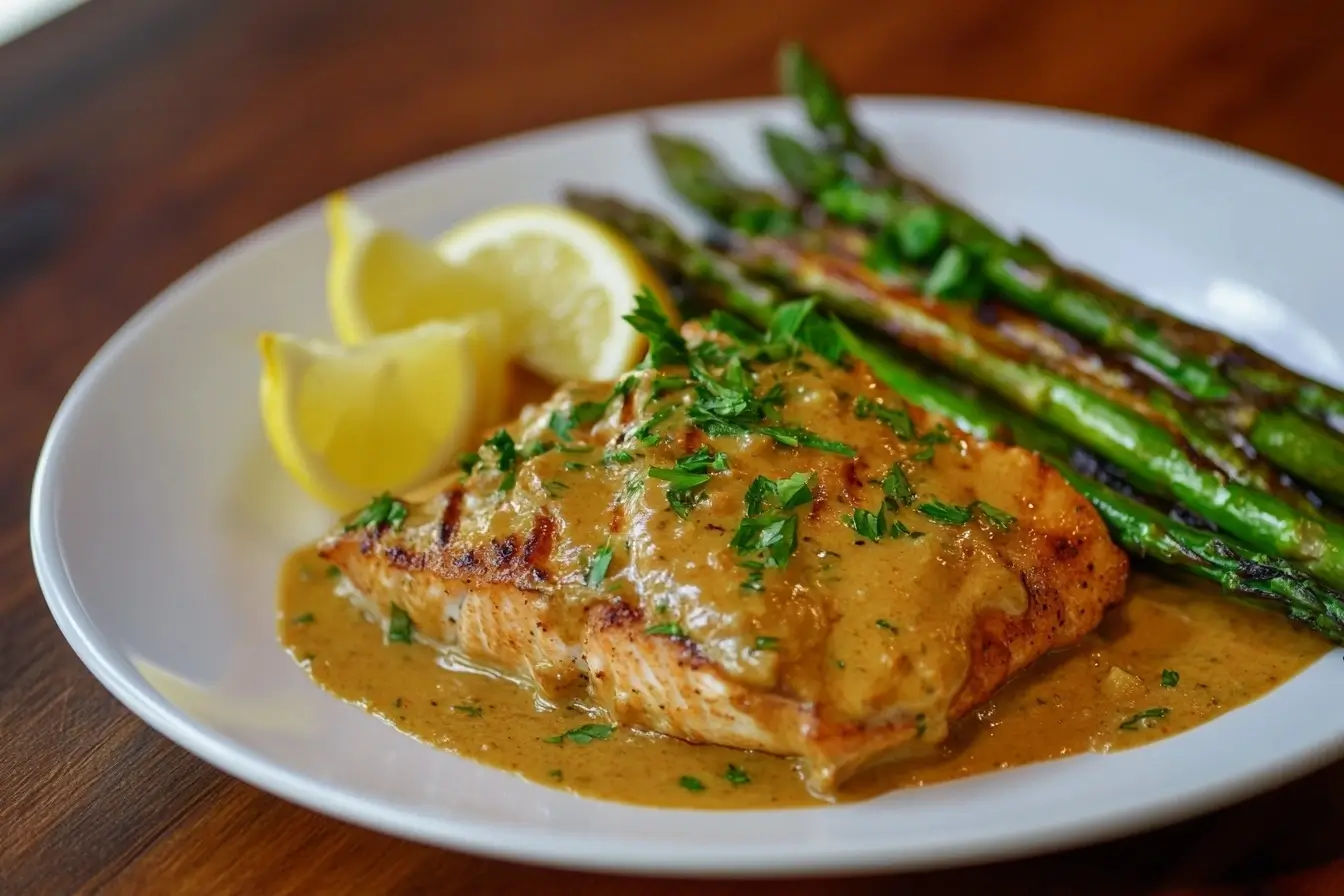Introduction to Mahi Mahi
Overview of Mahi Mahi
What spices are good with mahi mahi? If you’ve ever wondered how to season this mild and delicious fish, you’re in the right place. Emma still remembers the first time she cooked mahi mahi for her family—it was a rushed weekday evening, and she needed something quick, nutritious, and satisfying.
Commercial and sport fishermen prize mahi mahi for its fast growth, high yield, and firm, lean meat, making it a sustainable seafood choice. It is a staple in coastal cuisines, frequently featured in grilled, pan-seared, and baked dishes. Whether used in tacos, rice bowls, or fine dining entrees, its mild flavor and versatile texture make it a favorite among chefs and home cooks alike.
If you love the bold flavors and crispy crust of blackened mahi mahi, try this full recipe: Blackened Mahi Mahi Recipe – Quick, Flavorful, and Easy!. This method uses a blend of smoked paprika, cayenne, and aromatic spices to give your fish an incredible texture and taste.
Flavor Profile
Mahi mahi has a mild, slightly sweet taste, making it ideal for a variety of seasonings and marinades. Its firm yet flaky texture allows it to hold up well to grilling, pan-searing, and baking without falling apart.
Here’s how its flavor and texture compare to other popular fish:
| Fish Type | Flavor | Texture |
|---|---|---|
| Mahi Mahi | Mild, slightly sweet | Firm, flaky |
| Halibut | Mild, slightly buttery | Dense, flaky |
| Salmon | Rich, oily, slightly sweet | Medium-firm |
| Tuna | Meaty, mild | Very firm |
| Cod | Mild, neutral | Soft, flaky |
Because mahi mahi is not overly oily, it absorbs seasonings and marinades well. Citrus-based flavors, garlic, herbs, and spicy rubs work especially well with this fish, making it suitable for a variety of global cuisines.
Nutritional Benefits
Health Benefits
Mahi mahi is an excellent source of lean protein, making it a fantastic choice for those looking to build muscle, maintain a balanced diet, or follow a high-protein, low-fat meal plan. According to Healthline, consuming fish rich in omega-3 fatty acids, like mahi mahi, can help reduce inflammation, improve heart health, and support brain function.
Key Nutritional Benefits:
- Rich in Omega-3 Fatty Acids – Supports heart health, reduces inflammation, and improves brain function.
- High in Vitamin B12 – Essential for nerve health and red blood cell production.
- Packed with Selenium – A powerful antioxidant that helps combat cell damage.
- Good Source of Vitamin D – Supports bone health and immune function.
- Low in Mercury – Unlike larger fish like tuna, mahi mahi contains low mercury levels, making it a safer seafood option.
These benefits make mahi mahi an excellent choice for health-conscious eaters, especially those following Mediterranean, keto, or paleo diets.
Caloric Content
For those watching their calorie intake, mahi mahi is an ideal low-calorie seafood option. Here’s the nutritional breakdown for a 3.5-ounce (100g) serving of cooked mahi mahi:
| Nutrient | Amount |
|---|---|
| Calories | ~100-120 kcal |
| Protein | ~22-24g |
| Fat | ~1-2g |
| Carbohydrates | 0g |
| Omega-3 Fatty Acids | ~200-300 mg |
💡 Tip: For a low-calorie meal, pair mahi mahi with steamed vegetables and a light citrus sauce instead of heavy cream-based dressings.
What Spices Are Good with Mahi Mahi? Best Seasoning Guide
Mahi mahi’s mild, slightly sweet flavor makes it the perfect canvas for a variety of seasonings. Whether you prefer simple, fresh flavors or bold, spicy blends, the right seasoning can enhance this fish’s natural taste without overpowering it.
Basic Seasonings
Salt and Pepper – The Foundation of Flavor
Salt and pepper are the building blocks of great seasoning. A simple sprinkle of sea salt or kosher salt enhances the natural sweetness of mahi mahi, while black pepper adds a touch of warmth and mild heat.
For a more complex flavor, try:
- Himalayan pink salt – Adds subtle mineral notes.
- Smoked salt – Infuses a light smokiness.
- White pepper – Offers a milder, earthier alternative to black pepper.
💡 Tip: Lightly salting mahi mahi 10-15 minutes before cooking helps draw out excess moisture and allows the fish to absorb flavors more effectively.
Citrus Elements – A Fresh and Zesty Boost
Citrus is one of the best flavor enhancers for mahi mahi. The acidity brightens the dish, cuts through any richness, and balances bold seasonings.
- Lemon zest & juice – Classic and refreshing, perfect for a Mediterranean-style dish.
- Lime zest & juice – Adds a tropical touch, ideal for grilled or pan-seared mahi mahi.
- Orange zest – A subtle sweetness that pairs well with mild spices.
How to use:
- Grilled Mahi Mahi – Squeeze fresh lemon juice over the fish after grilling.
- Pan-Seared Mahi Mahi – Use a mix of lime zest and butter for a finishing sauce.
- Baked Mahi Mahi – Marinate the fish in citrus juice and olive oil before baking.
💡 Tip: Always use fresh citrus juice rather than bottled juice for the best flavor.
Herbs and Aromatics
Garlic and Onion – Depth and Richness
Garlic and onion add bold, savory depth to mahi mahi, whether used fresh, dried, or as part of a spice blend.
- Garlic powder & onion powder – Perfect for dry rubs, offering deep flavor without moisture.
- Fresh minced garlic & onion – Create a richer taste when sautéed or roasted.
- Shallots – A mild, slightly sweet alternative to onion.
💡 Tip: When grilling or searing, rub the fish with garlic-infused olive oil for a subtle, aromatic boost.
Fresh Herbs – A Burst of Green Goodness
Fresh herbs bring a vibrant, aromatic element to mahi mahi dishes. The best options include:
- Parsley – A light, clean taste that pairs well with citrus.
- Cilantro – Adds a fresh, slightly peppery note, great for tacos or tropical dishes.
- Basil – Works well in Italian and Mediterranean flavors, especially with tomatoes.
- Thyme – A mild, earthy herb that enhances buttery sauces.
- Dill – Slightly tangy, excellent for baked mahi mahi with a yogurt-based sauce.
💡 Tip: Always add fresh herbs at the end of cooking to preserve their bright flavors.
Spice Blends
Cajun Seasoning – A Bold, Spicy Kick
Cajun seasoning is one of the most popular ways to season mahi mahi, adding warm, smoky, and slightly spicy flavors.
Classic Cajun Blend:
- 1 teaspoon paprika
- ½ teaspoon cayenne pepper (adjust for heat)
- ½ teaspoon garlic powder
- ½ teaspoon onion powder
- ½ teaspoon dried thyme
- ½ teaspoon black pepper
- ½ teaspoon salt
How to use:
- Coat the fish lightly with oil, rub the seasoning over both sides, and grill or pan-sear for a flavorful crust.
- For a milder version, reduce the cayenne and add smoked paprika for depth.
💡 Tip: Cajun mahi mahi pairs perfectly with mango salsa for a balance of heat and sweetness.
Blackening Spice – The Secret to a Flavorful Crust
Blackening spice is similar to Cajun seasoning but has a heavier use of smoked paprika and cayenne, creating a crispy, charred crust when seared.
Blackening Spice Blend:
- 1 teaspoon smoked paprika
- ½ teaspoon cayenne pepper
- ½ teaspoon garlic powder
- ½ teaspoon onion powder
- ½ teaspoon black pepper
- ½ teaspoon dried oregano
- ½ teaspoon thyme
- ¼ teaspoon salt
How to use:
- Lightly coat the fish in melted butter or oil.
- Press the spice mixture into both sides.
- Sear in a hot cast-iron skillet over high heat for 2-3 minutes per side.
💡 Tip: Serve blackened mahi mahi with a cooling yogurt or avocado sauce to balance the heat.
Mediterranean Herbs – Earthy and Fragrant
For a more herb-forward, subtle seasoning, Mediterranean spices bring out the natural sweetness of mahi mahi.
Mediterranean Spice Mix:
- 1 teaspoon oregano
- ½ teaspoon thyme
- ½ teaspoon rosemary
- ½ teaspoon garlic powder
- ½ teaspoon lemon zest
- ¼ teaspoon salt and black pepper
How to use:
- Grilled or Baked Mahi Mahi – Rub the seasoning onto the fish and drizzle with olive oil before cooking.
- Mediterranean Fish Bowls – Serve with quinoa, roasted veggies, and feta cheese.
💡 Tip: Add a final drizzle of extra virgin olive oil and fresh lemon juice for an authentic Mediterranean touch.
Cooking Techniques and Spice Application
Mahi mahi is incredibly versatile and can be cooked using various techniques, each bringing out different flavors and textures. Whether you’re grilling, pan-searing, or baking, the right seasoning and cooking method will ensure a perfect, flavorful dish.
Grilling Mahi Mahi
Preparation and Seasoning
Grilling brings out the natural sweetness of mahi mahi while adding a smoky depth. Before grilling, it’s essential to marinate the fish to enhance its flavor and keep it from drying out.
Simple Grilled Mahi Mahi Marinade:
- 2 tablespoons olive oil
- 1 tablespoon lemon juice or lime juice
- 1 teaspoon garlic powder
- ½ teaspoon salt
- ½ teaspoon black pepper
- ½ teaspoon paprika (for smokiness)
- ¼ teaspoon cayenne pepper (optional for heat)
- 1 teaspoon dried oregano or thyme
How to Marinate:
- Whisk all ingredients together in a bowl.
- Coat the mahi mahi fillets evenly with the marinade.
- Let the fish marinate for 15-30 minutes (not longer, as citrus can start breaking down the texture).
💡 Tip: If short on time, simply brush the fish with olive oil, lemon juice, salt, and pepper before grilling.

Grill Execution
- Preheat the grill to medium-high heat (375-400°F / 190-200°C) and lightly oil the grates to prevent sticking.
- Place the fish on the grill and cook for 3-4 minutes per side, flipping once. The fish should have nice grill marks and release easily when it’s time to flip.
- Check for doneness by using a fork—mahi mahi should be opaque and flake easily. The internal temperature should reach 137°F (58°C).
- Remove from the grill and let the fillet rest for 2 minutes to lock in juices.
💡 Tip: If grilling a skin-on fillet, start with skin-side down for crispiness. Serve with a drizzle of lemon butter sauce for extra flavor.

Pan-Searing Mahi Mahi
Seasoning Before Searing
Pan-searing creates a crispy, golden-brown crust while keeping the inside tender. The key to success is using a dry spice rub instead of a wet marinade.
Quick Spice Rub for Pan-Seared Mahi Mahi:
- 1 teaspoon smoked paprika
- ½ teaspoon garlic powder
- ½ teaspoon onion powder
- ¼ teaspoon cayenne pepper (optional)
- ½ teaspoon dried thyme
- Salt and black pepper to taste
How to Season:
- Pat the mahi mahi fillet dry with a paper towel.
- Lightly coat both sides with olive oil to help the seasoning stick.
- Sprinkle the spice rub evenly over the fish.
💡 Tip: Use high-smoke-point oils like avocado oil, canola oil, or grapeseed oil for the best sear.
Creating Pan Sauces
A pan sauce enhances flavor and moisture, making the dish more vibrant. After searing the fish, use the same pan to make a quick sauce.
Easy Lemon-Garlic Butter Sauce:
- Remove the cooked fish from the pan and set it aside.
- Add 1 tablespoon butter and 1 minced garlic clove to the pan. Sauté for 30 seconds.
- Pour in ¼ cup chicken or vegetable broth and 1 tablespoon lemon juice to deglaze the pan.
- Simmer for 1-2 minutes, then spoon over the fish.
💡 Tip: For a creamy sauce, stir in a spoonful of Greek yogurt or coconut milk instead of heavy cream.
Baking Mahi Mahi
Seasoning Techniques
Baking mahi mahi locks in moisture, making it an excellent method for a tender and flavorful dish. The best way to season baked mahi mahi is with herb-infused butter or oil.
Lemon Herb Butter for Baking:
- 2 tablespoons melted butter or olive oil
- 1 teaspoon garlic powder
- ½ teaspoon salt
- ½ teaspoon dried oregano or thyme
- 1 teaspoon lemon zest
How to Season:
- Brush the butter mixture onto the mahi mahi fillets before baking.
- For extra moisture, add lemon slices and fresh herbs on top.
💡 Tip: Baking in foil seals in juices—wrap the fish with lemon, garlic, and herbs for the best results.
Baking Tips
- Preheat the oven to 375°F (190°C).
- Line a baking sheet with parchment paper and place the fillets on top.
- Bake for 12-15 minutes, depending on thickness.
- Check for doneness—the fish should be opaque and flake easily at 137°F (58°C).
- Optional: Broil for the last 2 minutes for a lightly crisped top.
💡 Tip: Serve with a side of quinoa salad or roasted vegetables for a healthy, well-rounded meal.
Complementary Side Dishes
A well-seasoned mahi mahi fillet is delicious on its own, but pairing it with the right side dishes can turn it into a complete, restaurant-quality meal. From starches to vegetables and flavorful sauces, here are some of the best accompaniments to serve with mahi mahi.
Starches
Rice Pilaf – A Fragrant, Herby Pairing
Rice pilaf is a classic, versatile side dish that absorbs flavors well, making it a great match for mahi mahi. Instead of plain white rice, pilaf is cooked with aromatics and broth, giving it a richer taste.
Easy Herb-Infused Rice Pilaf:
- Heat 1 tablespoon olive oil in a pot over medium heat.
- Sauté ½ cup chopped onion and 1 minced garlic clove until soft.
- Stir in 1 cup long-grain rice and cook for 1 minute to toast the grains.
- Add 2 cups chicken or vegetable broth, ½ teaspoon salt, and ¼ teaspoon black pepper.
- Cover and simmer for 15-18 minutes until the rice is tender.
- Stir in fresh parsley, thyme, or cilantro before serving.
💡 Tip: Add a squeeze of lemon juice for extra brightness, especially if your mahi mahi is citrus-seasoned.
Quinoa Salad – A Light and Nutritious Option
For a healthier alternative to rice, quinoa is an excellent choice. It’s high in protein, naturally gluten-free, and has a slightly nutty flavor that pairs well with seafood.
Quick Quinoa Salad Recipe:
- Cook 1 cup quinoa in 2 cups water until fluffy. Let it cool.
- Toss with cherry tomatoes, cucumbers, red onion, and chopped cilantro.
- Drizzle with olive oil, lemon juice, salt, and black pepper.
- Mix well and serve chilled or at room temperature.
💡 Tip: This salad works particularly well with grilled or blackened mahi mahi, balancing out the bold spices with its fresh, crisp texture.
Vegetables
Grilled Asparagus – A Simple, Flavorful Side
Grilled asparagus is a quick and nutritious side that enhances the flavors of mahi mahi without overpowering them.
How to Make Perfect Grilled Asparagus:
- Preheat your grill to medium-high heat (375°F / 190°C).
- Toss 1 bunch of asparagus with 1 tablespoon olive oil, salt, and black pepper.
- Grill for 3-4 minutes, turning occasionally, until slightly charred but still crisp.
- Finish with a squeeze of lemon juice or a sprinkle of Parmesan cheese.
💡 Tip: If you don’t have a grill, roast asparagus in the oven at 400°F (200°C) for 12-15 minutes.
Roasted Vegetables – A Seasonal Mix with Herbs
A mix of roasted vegetables is a great way to add color and variety to your plate.
Simple Roasted Vegetable Recipe:
- Chop bell peppers, zucchini, carrots, and red onion into bite-sized pieces.
- Toss with olive oil, salt, black pepper, garlic powder, and dried thyme.
- Spread on a baking sheet and roast at 400°F (200°C) for 20-25 minutes.
- Serve warm alongside your mahi mahi.
💡 Tip: Add a pinch of cumin or smoked paprika for an extra depth of flavor.
Sauces and Condiments
Mango Salsa – A Sweet and Spicy Topping
Mahi mahi pairs beautifully with fruity and slightly spicy flavors. Mango salsa adds a tropical freshness that balances savory spices.
Quick Mango Salsa Recipe:
- Dice 1 ripe mango, ½ red bell pepper, and ¼ red onion.
- Add 1 chopped jalapeño (optional for heat) and ¼ cup fresh cilantro.
- Squeeze in the juice of 1 lime and sprinkle with salt and black pepper.
- Toss well and let sit for 5 minutes before serving.
💡 Tip: This salsa is perfect for grilled mahi mahi and works well in fish tacos!
Tartar Sauce – A Classic with a Twist
Tartar sauce is a creamy, tangy condiment that complements mahi mahi, especially when pan-seared or baked.
Homemade Tartar Sauce Recipe:
- In a bowl, mix ½ cup Greek yogurt or mayonnaise, 1 tablespoon chopped pickles, and 1 teaspoon lemon juice.
- Stir in ½ teaspoon garlic powder, ½ teaspoon Dijon mustard, and a pinch of salt.
- Add chopped fresh dill or parsley for extra flavor.
💡 Tip: Using Greek yogurt instead of mayo makes this a lighter, protein-packed alternative.

Frequently Asked Questions (FAQs)
How to Make Blackened Mahi Mahi?
Blackened mahi mahi is a spicy, flavorful dish where the fish is coated in a bold seasoning mix and seared at high heat to create a dark, crispy crust.
Step-by-Step Blackened Mahi Mahi Recipe:
- Prepare the seasoning: Mix 1 teaspoon smoked paprika, ½ teaspoon garlic powder, ½ teaspoon onion powder, ¼ teaspoon cayenne pepper, ½ teaspoon dried thyme, salt, and black pepper.
- Coat the fish: Lightly brush both sides of the mahi mahi fillet with olive oil or melted butter and generously rub the seasoning blend over it.
- Heat the pan: Use a cast-iron skillet or heavy pan over medium-high heat. Add 1 tablespoon of oil (avocado or canola oil works best).
- Cook the fish: Sear for 3-4 minutes on each side until a dark crust forms. The inside should remain tender and flaky.
- Serve immediately, with a squeeze of lemon or a spoonful of mango salsa.
💡 Tip: For a spicier kick, increase the amount of cayenne or add red pepper flakes.
If you want to prepare the perfect blackened mahi mahi with a well-seasoned crust, follow this step-by-step guide: Easy Blackened Mahi Mahi Recipe – How to Make It at Home. This recipe covers everything from seasoning to cooking techniques to achieve a restaurant-quality dish.
What Is the Difference Between Grilled and Blackened Mahi Mahi?
The main difference between grilled and blackened mahi mahi comes down to the cooking method and seasoning:
| Feature | Grilled Mahi Mahi | Blackened Mahi Mahi |
|---|---|---|
| Cooking Method | Cooked over direct heat on a grill | Seared in a hot pan (usually cast iron) |
| Seasoning | Light, fresh flavors (salt, pepper, citrus, herbs) | Bold, smoky, and slightly spicy seasoning |
| Texture | Firm but slightly smoky | Crispy, dark crust with a tender interior |
| Best Oils | Olive oil or butter | High-smoke-point oils (avocado, canola) |
💡 Tip: If you love charred, smoky flavors, go for blackened mahi mahi. If you prefer lighter, more delicate seasoning, grilling is the way to go!
Want a deeper comparison between these two cooking styles? Read our full article: Grilled vs. Blackened Mahi Mahi: 5 Key Differences You Must Know!. This guide explains the key differences in seasoning, cooking techniques, and texture to help you choose the best method.
What to Serve with Blackened Mahi Mahi?
Blackened mahi mahi has bold flavors, so it pairs well with refreshing, slightly sweet, or creamy sides to balance the heat. Some great options include:
- Coconut Rice – The slight sweetness complements the spice.
- Mango Salsa – A fresh, fruity topping that adds brightness.
- Garlic Butter Asparagus – A simple, flavorful veggie side.
- Corn Salad – A mix of corn, tomatoes, red onion, and cilantro.
- Coleslaw – A cool, creamy contrast to the heat of the fish.
💡 Tip: If serving blackened mahi mahi in tacos, try pairing it with avocado crema and shredded cabbage for a delicious balance of textures and flavors.
Looking for more side dish ideas to pair with your blackened mahi mahi? Check out our complete guide: What to Serve with Blackened Mahi Mahi: Best Side Dishes & Pairings. This article features the best rice dishes, grilled vegetables, and sauces to balance the bold flavors of blackened seasoning.
What Fish Can I Use Instead of Mahi Mahi for This Recipe?
If you can’t find mahi mahi, several other firm, mild-flavored fish work just as well in these recipes. Great substitutes include:
- Tilapia – Mild and budget-friendly, though slightly more delicate.
- Halibut – Firm and meaty, with a mild taste.
- Cod – Flaky, but works well with seasonings.
- Snapper – Slightly sweeter and great for grilling.
- Grouper – Firm texture with a mild, buttery flavor.
💡 Tip: If substituting a more delicate fish like tilapia or cod, be gentle when flipping it to prevent breaking.
What Spices Pair Best with Mahi Mahi?
Mahi mahi’s mild, slightly sweet flavor allows it to work well with a variety of spices. The best spices for mahi mahi include:
- Paprika – Adds a mild smokiness and enhances color.
- Garlic Powder – Provides a savory, rich depth of flavor.
- Citrus Zest (Lemon, Lime, or Orange) – Brightens and balances the fish’s natural sweetness.
- Cumin – Brings warmth and earthiness, ideal for tropical and Latin flavors.
- Cayenne Pepper or Red Pepper Flakes – Adds heat and depth for spicier dishes.
- Dried Oregano and Thyme – Perfect for Mediterranean-style preparations.
💡 Tip: For an all-purpose seasoning, mix paprika, garlic powder, black pepper, and dried oregano!
Can I Use Pre-Made Spice Blends for Mahi Mahi?
Yes! Pre-made spice blends are great for quick and easy seasoning. Some of the best options include:
- Cajun Seasoning – A bold, slightly spicy mix of paprika, cayenne, garlic, and onion powder.
- Blackening Spice – Similar to Cajun but with a focus on smoked paprika and thyme for a charred crust.
- Mediterranean Seasoning – A mix of oregano, thyme, garlic, and lemon zest for a bright, herbaceous flavor.
- Taco Seasoning – Cumin, chili powder, garlic, and onion powder for a Mexican-style dish.
💡 Tip: Always check sodium levels in store-bought blends—some may be salt-heavy!
How Long Should I Marinate Mahi Mahi?
Marination time depends on the type of marinade:
- Citrus-Based Marinades (Lemon/Lime Juice, Vinegar) – 15-30 minutes (longer can break down the fish).
- Oil-Based Marinades (Olive Oil, Herb Mixes) – 30 minutes to 2 hours for deeper flavor.
- Dry Spice Rubs – Can be applied right before cooking or left on for up to 1 hour.
💡 Tip: For a quick burst of flavor, brush the fillet with oil, sprinkle with spices, and let it sit for 10 minutes before cooking.
Is Mahi Mahi Suitable for Grilling?
Yes! Mahi mahi is one of the best fish for grilling because of its firm texture and ability to hold up to high heat.
Why Mahi Mahi Is Great for Grilling:
- Doesn’t fall apart like flakier fish.
- Absorbs marinades and seasonings well.
- Develops beautiful grill marks and a lightly charred crust.
- Cooks quickly – only about 3-4 minutes per side.
💡 Tip: To prevent sticking, lightly oil the grill grates before cooking and use a fish spatula for flipping.
That wraps up everything you need to know about seasoning, cooking, and pairing mahi mahi! Whether you’re grilling, blackening, or baking, these tips and recipes will help you create a flavorful seafood dish every time. 🍽️

